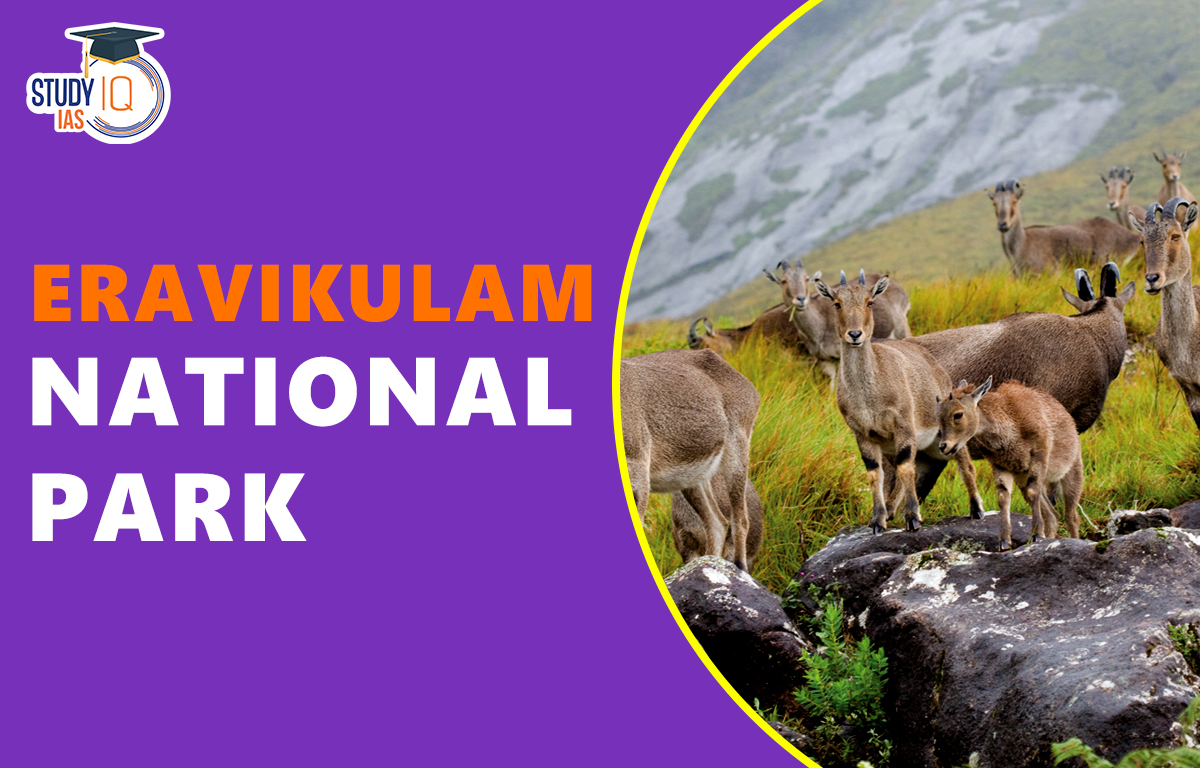Table of Contents
Eravikulam National Park
Kerala’s Eravikulam and Idukki regions are home to the Eravikulam National Park. It is situated in the Western Ghats. The Nilgiri Tahr is the park’s most well-known animal. Of all Nilgiri Tahr, it has the highest population. A flower that emerges once every twelve years is another unique feature of Eravikulam National Park. The blossom is called Neelakurinji. The name of the national park is derived from a special blossom that only grows in this area. The UPSC Syllabus includes Eravikulam National Park and all national parks as a significant topic of Environment subject. The UPSC Mock Test can help candidates prepare for the exam with more precision.
Eravikulam National Park History
Under the Kannan Devan Hill Produce (Resumption of lands) Act of 1971, the Keralan government purchased the property from the Kannan Devan Hills Produce Company. Eravikulam-Rajamala Wildlife Sanctuary was founded in 1975, and it was granted the designation of National Park in 1978.
Eravikulam National Park Feature
Eravikulam National Park is situated in the Devikulam Taluk of the Idukki District, Kerala, in the High Ranges (Kannan Devan Hills) of the Southern Western Ghats. It covers a land area of 97 square kilometres and is home to Anamudi, the highest mountain in South India at 2695 metres. The Rajamalai section of the forest is always accessible to tourists.
Also Read: Dudhwa National Park
Eravikulam National Park Topography
The park’s main area is a high rolling plateau with a base elevation of about 2000 metres above mean sea level (plateau at various elevations or with varying heights). Grasslands, shrublands, and shola forests make up the park’s three main plant community groups (mosaic of montane evergreen forests and grasslands). The park is the Western Ghats’ longest and least-disturbed section of the rare Montane Shola-Grassland vegetation.
Also Read: Manas National Park
Eravikulam National Park Flora
Eravikulam National Park houses the special Neelakurinji flowers (Strobilanthes kunthianam) that bloom once every 12 years and the next sighting is expected to be in 2030. It also has uncommon terrestrial and epiphytic orchids, wild balsams, and other plants. An epiphyte is a living thing that develops on the top of a plant and gets its nutrients and moisture from the air, water, rain, or accumulated debris.
Eravikulam National Park Fauna
The Nilgiri Tahr, an endangered species, has the biggest remaining population in the park. (Nilgiritragus hylocrius). It also has lesser-known species of wildlife, including the Nilgiri Marten, Ruddy Mongoose, Small Clawed Otter, and Dusky Striped Squirrel.
Eravikulam National Park Vegetation
Rolling grasslands make up the majority of the park, but the upper portion of the valley also has a few shola forest patches. A few examples of significant plants are Actinodaphne bourdilloni, Microtropis ramiflora, Pittosporum tetraspermium, Sysygium aronottianum, Chrysopogon Zelanieus, Eupatorium adenophorum, Strobilanthus Kunthianus (Neela Kurinji), Eulalia phaeothrix, Tripogen bromodes.
Eravikulam National Park Wildlife Population
There are 29 different species of animals present here, 5 of which are unique to the Western Ghats. Common wildlife includes the Nilgiri Tahr, Gaur, Sloth Bear, Nilgiri Langur, Tiger, Leopard, Giant Squirrel, and wild canine. Here, the Nilgiri Tahr, an endangered species, has half of its global number. Civet cats and jungle cats reside in the Sholas, whereas panthers are typically seen in open plains. This park is home to the Atlas moth, which is the biggest of its kind in the entire globe. Here, more than 100 different butterfly species have been identified. Additionally, 20 different kinds of amphibians can be found here.
Eravikulam National Park Significance
It plays a crucial role in the region as a catchment area for rivers moving east (tributaries of the River Pambar) and west (tributaries of the River Periyar and Chalakkudy). It is significant locally for preserving the climate, supplying drinking water to the nearby estates, and for irrigation.
Eravikulam National Park UPSC
In order to safeguard the Nilgiri Tahr region’s native people, it was made a sanctuary in 1975. (highly endangered mountain goat). But in 1978, because of its ecological, flora, wildlife, geomorphologic, and zoological significance, it was designated as a national park. Additionally, this is the home of “Neelakurinji,” a flower that only emerges every twelve years. Students can read all the details related to UPSC by visiting the official website of StudyIQ UPSC Online Coaching.


 Nilgiri Biosphere Reserve, Map, Climate,...
Nilgiri Biosphere Reserve, Map, Climate,...
 Repo Rate and Reverse Repo Rate, Impact ...
Repo Rate and Reverse Repo Rate, Impact ...
 Foreign Contribution Regulation Act (FCR...
Foreign Contribution Regulation Act (FCR...





















